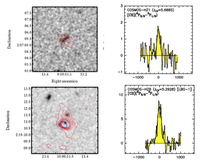Physics and Dynamics of the First Galaxies
 The sensitivity of ALMA has opened up a new era in the study of galaxy formation through the use of the strong atomic fine structure lines coming from the cool ISM, in particular, the [CII] 158 micron line. This is the strongest emission line from star-forming galaxies from the far infrared through the radio, and is the dominant cooling mechanism for cool interstellar gas. This line redshifts into the ALMA bands at z > 1. Capak et al. have detected [CII] in samples of typical star-forming galaxies – star formation rates of a few to 100 M⊙ per year – at z = 5.2 to 6.2. This represents a new window on galaxy formation in terms of studying gas dynamics and dark matter, ISM physics, and determining redshifts for the first galaxies.
The sensitivity of ALMA has opened up a new era in the study of galaxy formation through the use of the strong atomic fine structure lines coming from the cool ISM, in particular, the [CII] 158 micron line. This is the strongest emission line from star-forming galaxies from the far infrared through the radio, and is the dominant cooling mechanism for cool interstellar gas. This line redshifts into the ALMA bands at z > 1. Capak et al. have detected [CII] in samples of typical star-forming galaxies – star formation rates of a few to 100 M⊙ per year – at z = 5.2 to 6.2. This represents a new window on galaxy formation in terms of studying gas dynamics and dark matter, ISM physics, and determining redshifts for the first galaxies.
Image: [CII] 158 micron emission and thermal dust emission from z ~ 5.5 galaxies
Science Team: P.L. Capak (IPAC, Caltech), C. Carilli (NRAO, Cavendish), G. Jones (New Mexico Tech), C.M. Casey (University of Texas), D. Riechers (Cornell University), K. Sheth (NRAO), C.M. Carollo (ETH Zurich), O. Ilbert (CNRS), A. Karim (Argelander Institute für Astronomie), O. LeFevre (CNRS), S. Lilly (NRAO), N. Scovill (Caltech), V. Smolcic (University of Zagreb), and L. Yan (IPAC, Caltech).
Publication: Galaxies at Redshifts 5 to 6 with Systematically Low Dust Content and High [C II] Emission, 2015, Nature 522, 455.




Connect with NRAO